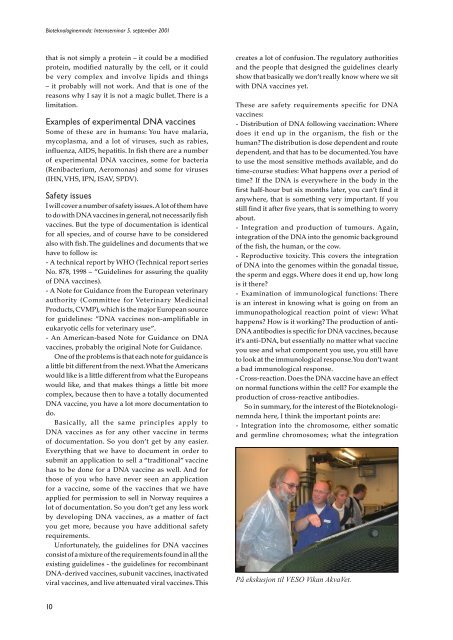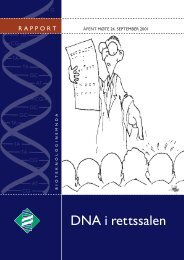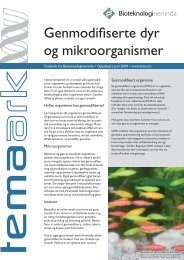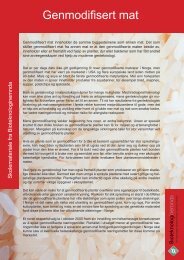Bioteknol<strong>og</strong>inemnda: <strong>Internseminar</strong> 5. september 2001that is not simply a protein – it could be a modifiedprotein, modified naturally by the cell, or it couldbe very complex and involve lipids and things– it probably will not work. And that is one of thereasons why I say it is not a magic bullet. There is alimitation.Examples of experimental DNA vaccinesSome of these are in humans: You have malaria,mycoplasma, and a lot of viruses, such as rabies,influenza, AIDS, hepatitis. In fish there are a numberof experimental DNA vaccines, some for bacteria(Renibacterium, Aeromonas) and some for viruses(IHN, VHS, IPN, ISAV, SPDV).Safety issuesI will cover a number of safety issues. A lot of them haveto do with DNA vaccines in general, not necessarily fishvaccines. But the type of documentation is identicalfor all species, and of course have to be consideredalso with fish. The guidelines and documents that wehave to follow is:- A technical report by WHO (Technical report seriesNo. 878, 1998 – ”Guidelines for assuring the qualityof DNA vaccines).- A Note for Guidance from the European veterinaryauthority (Committee for Veterinary MedicinalProducts, CVMP), which is the major European sourcefor guidelines: ”DNA vaccines non-amplifiable ineukaryotic cells for veterinary use”.- An American-based Note for Guidance on DNAvaccines, probably the original Note for Guidance.One of the problems is that each note for guidance isa little bit different from the next. What the Americanswould like is a little different from what the Europeanswould like, and that makes things a little bit morecomplex, because then to have a totally documentedDNA vaccine, you have a lot more documentation todo.Basically, all the same principles apply toDNA vaccines as for any other vaccine in termsof documentation. So you don’t get by any easier.Everything that we have to document in order tosubmit an application to sell a “traditional” vaccinehas to be done for a DNA vaccine as well. And forthose of you who have never seen an applicationfor a vaccine, some of the vaccines that we haveapplied for permission to sell in Norway requires alot of documentation. So you don’t get any less workby developing DNA vaccines, as a matter of factyou get more, because you have additional safetyrequirements.Unfortunately, the guidelines for DNA vaccinesconsist of a mixture of the requirements found in all theexisting guidelines - the guidelines for recombinantDNA-derived vaccines, subunit vaccines, inactivatedviral vaccines, and live attenuated viral vaccines. Thiscreates a lot of confusion. The regulatory authoritiesand the people that designed the guidelines clearlyshow that basically we don’t really know where we sitwith DNA vaccines yet.These are safety requirements specific for DNAvaccines:- Distribution of DNA following vaccination: Wheredoes it end up in the organism, the fish or thehuman? The distribution is dose dependent and routedependent, and that has to be documented. You haveto use the most sensitive methods available, and dotime-course studies: What happens over a period oftime? If the DNA is everywhere in the body in thefirst half-hour but six months later, you can’t find itanywhere, that is something very important. If youstill find it after five years, that is something to worryabout.- Integration and production of tumours. Again,integration of the DNA into the genomic backgroundof the fish, the human, or the cow.- Reproductive toxicity. This covers the integrationof DNA into the genomes within the gonadal tissue,the sperm and eggs. Where does it end up, how longis it there?- Examination of immunol<strong>og</strong>ical functions: Thereis an interest in knowing what is going on from animmunopathol<strong>og</strong>ical reaction point of view: Whathappens? How is it working? The production of anti-DNA antibodies is specific for DNA vaccines, becauseit’s anti-DNA, but essentially no matter what vaccineyou use and what component you use, you still haveto look at the immunol<strong>og</strong>ical response. You don’t wanta bad immunol<strong>og</strong>ical response.- Cross-reaction. Does the DNA vaccine have an effecton normal functions within the cell? For example theproduction of cross-reactive antibodies.So in summary, for the interest of the Bioteknol<strong>og</strong>inemndahere, I think the important points are:- Integration into the chromosome, either somaticand germline chromosomes; what the integrationPå ekskusjon til VESO Vikan AkvaVet.10
<strong>Fiskevaksiner</strong> <strong>og</strong> genteknol<strong>og</strong>ican lead to: for example, uncontrolled cell division,or inactivation of genes that you need.- Vertical transmission, passing it on to the nextgeneration.- The immunopathol<strong>og</strong>ical reactions: unwantedbiol<strong>og</strong>ical effects, for example the co-expression ofcytokines. This has to do both with DNA vaccines ingeneral and with putting in other proteins of interestto express at the same time. This is really no differentfrom the documentation required for a normal vaccinewhen you add in multiple components.Points to considerProbably the most important points to consider herecover three aspects:1. Source of the componentsThere are no components included without a reason.What are the standard control elements used in labDNA vaccines, very early in research? All vectors willcontain a promoter element and a polyA element. Inthe most commonly used vectors in “early stagereasearch”, the promoter’s origin is actually a virus,related to the production of cancer, CMV. The polyAthat is commonly used, again because it is a typicalplasmid that one can buy right of the shelf, is actuallya controlling element from the gene for bovine growthhormone (BGH). Both of them are part of a standardplasmid, and both of them are of course things thatwe have to think about if we are going to make a DNAvaccine. Now, from a scientific point of view, theseelements are simply controlling elements, they haveno risk over similar control elements from other genes.If instead of a strong promoter like CMV promoter, Itook a strong promoter, a strong controlling elementfrom a fish, from an insect, from a moose, or from apenguin, basically there is no more danger in that thanthere is from the CMV. If I took a polyA from a penguininstead of from the bovine growth hormone gene, thereis no more danger in using that than there is in usinganything else. Because they are controlling elements,they have really nothing to do with specifically thevirus or the gene, they simply control the expressionof what is in between these two elements. An anal<strong>og</strong>ywould be that if you buy a steering wheel for a car, forexample from a Mercedes-Benz, and you put it on aVolkswagen, it does not change the Volkswagen into aMercedes-Benz – it is still a Volkswagen that you cansteer with the Mercedes-Benz steering wheel.The fact that a gene is controlled by the CMVpromoter doesn’t make it a virus, it is simply acontrolling element that has been isolated from anorganism. But, public opinion, regulatory opinionand perception mean something as well. And so atleast from my point of view, and from my company’spoint of view, and I would imagine from the point ofview of everybody that is looking towards buying orselling a DNA vaccine, no mammalian based or viralbased elements are needed in today’s or tomorrow’scommercial DNA vaccines, apart from those genesthat we are using to produce the immunol<strong>og</strong>icalresponse. Scientifically, that CMV promoter is nodifferent from a promoter from a penguin, butbecause of regulatory worries, and because of publicperception that you have a ”something DNA froma virus that causes cancer”, we will not use it, andthere is in fact no need to use it. And I don’t thinkthere is a respectable company that will ever comeout with a commercial DNA vaccine that will havethese elements on it.2. Antibiotic resistance and selection markersFrom research done in humans and human models,which is basically monkeys and mice, there has beenno documented evidence of a transferred resistancegene due to a DNA vaccine. There are limitations inthis research: Virtually all the work has been done inmice, monkeys, and to some degree in humans; andit has been done on intramuscular vaccines, whereyou take the DNA and squirt it into a muscle. Sothe number of animals that have been looked at arelimited, and the number of experiments that havebeen done to look at it are limited. But there has beenno documentation of transfer of a resistance gene toa human or to a bacterium. As I said, this is generallybased on intramuscular injection of humans andhuman models. In fish, we haven’t seen it either, butagain the number of experiments are small.NN: But is this a scientifically relevant argument,since what you are scared of is an idiosyncratic eventthat may take place very seldom, but may be seriouswhen it takes place? So lack of significant evidencedoes not prove anything, since what you are lookingfor is the very seldom event that may happen sinceyou have so many vaccinations?McDougall: I agree, but again, I refer back toperception as well. And the question comes up: Whatabout this resistance? The question is somewhat moreof interest with fish, because of the routes by whichyou can vaccinate. If you do an immersion vaccinewith naked DNA, then you have a container full ofwater that has floating DNA around it with thesemarkers. Then you have to make sure that you simplydon’t take that DNA and dump it into the sea afteryou have vaccinated. So of course, it depends on theroute. What I am saying right now is that we don’thave any evidence that suggests that there is transferof resistance genes. But few animals have been lookedat. Both the FDA and USDA, who have done a lot ofexperiments themselves, accept these findings. Ofcourse, that means little in Europe because other thanproduction facilities that they can control, that doesn’tmean so much, but it does mean that they accept thatin fact there has been little transfer.11
















